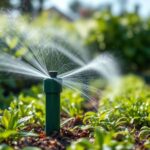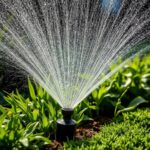What is the Minimum Distance Between a Sprinkler and a Wall? Essential Guidelines for Effective Sprinkler System Design

In the realm of irrigation and fire protection, the positioning of sprinklers is crucial for optimal performance and efficiency. One critical consideration is the minimum distance between a sprinkler head and a wall, which significantly affects water distribution and overall system effectiveness. Understanding these guidelines is essential for designers and installers to create systems that not only meet safety standards but also ensure the best coverage. This article delves into the key factors influencing the placement of sprinklers in relation to walls, providing essential insights and recommendations for effective sprinkler system design.
Understanding Minimum Clearance Between Sprinklers and Walls
The minimum distance between a sprinkler and a wall is vital for ensuring optimal sprinkler performance and effective fire suppression. According to the National Fire Protection Association (NFPA) guidelines, it is generally recommended that sprinklers should be installed at least 4 inches away from any wall to allow for adequate water distribution and prevent obstruction of the sprinkler's spray pattern. This distance can vary based on sprinkler type, orientation, and specific fire codes, emphasizing the importance of consulting local regulations to achieve compliance and safety.
Importance of Proper Installation
Proper installation of sprinklers maintains their effectiveness in case of a fire emergency. If a sprinkler is too close to a wall, it may cause water to be redirected, reducing the overall coverage area and the effectiveness of the system. It's crucial to follow the minimum distance requirements to ensure that the sprinkler can deploy water effectively across the intended area.
Impact on Water Distribution
The positioning of a sprinkler relative to the wall significantly impacts its water distribution capabilities. When the minimum distance is maintained, the spray pattern is not obstructed, allowing for an even distribution of water across the potential fire area. This dispersal is vital for controlling and extinguishing fires quickly.
Local Codes and Regulations
Each jurisdiction may have different local codes and regulations that specify unique requirements for sprinkler installation. It is important for builders and property managers to familiarize themselves with these codes to ensure that the installation meets all safety standards while adhering to local laws regarding the minimum distance from walls and other obstructions.
See also:
Factors Affecting Minimum Distance
Several factors can affect the minimum distance required between a sprinkler and a wall, including the type of sprinkler head used, room layout, and ceiling height. Some sprinkler types, such as horizontal sidewall sprinklers, may have differing requirements, making it essential to consult the manufacturer's specifications and the relevant NFPA standards for guidance.
Common Mistakes to Avoid
One of the common mistakes in sprinkler installation is placing sprinklers too close to walls or ceilings without considering the required clearance. Such oversights can lead to ineffective suppression and potential legal liability issues if a fire event occurs and the system fails. It is crucial to adhere strictly to installation guidelines to avoid these pitfalls.
| Factor | Recommended Minimum Distance |
|---|---|
| Standard Sprinklers | 4 inches |
| Sidewall Sprinklers | 6 inches |
| Ceiling Sprinklers | 18 inches |
| Obstructions (e.g., beams) | 1 foot |
Understanding the Clearance Requirements for Optimal Sprinkler Performance
The minimum distance between a sprinkler and a wall is crucial for ensuring that the sprinkler system operates effectively. Proper clearance allows for adequate water distribution and coverage, preventing areas from becoming insufficiently watered or damaged by excessive pressure. Typically, the industry standard ranges from 4 to 12 inches depending on the type of sprinkler head and specific installation guidelines provided by the manufacturer. It is essential to adhere to these distances to maintain not only the efficiency of the system but also the safety of the environment it serves.
Factors Influencing Minimum Distance Requirements
Several factors can influence the minimum distance required between a sprinkler and a wall, including the type of sprinkler head installed, water pressure, and the design of the overall irrigation system. For example, traditional spray heads generally need a shorter distance than rotary heads due to their distinct operation and water distribution patterns. Understanding these factors is vital to achieving optimal performance and avoiding overspray or water wastage.
Building Codes and Regulations
It is essential to consider local building codes and fire safety regulations when determining the minimum distance between a sprinkler and a wall. These regulations may vary by location and can dictate specific distances to ensure safety and effectiveness in fire suppression. Always consult with local authorities or a trained professional to ensure the sprinkler layout complies with regional requirements and standards.
See also:
Impact of Wall Materials
The material of the wall adjacent to the sprinkler can significantly impact the required distance. For instance, non-combustible materials may allow for closer placement, whereas flammable materials such as wood may require a larger clearance to prevent fire hazards. Understanding these interactions is critical to designing an effective and compliant sprinkler system that safeguards both property and occupants.
Testing and Maintenance Considerations
When designing a sprinkler system, regular *testing* and maintenance should be factored into the planning of the minimum distance from walls. Ensuring that sprinklers are adequately spaced allows for easier maintenance access and reduces the likelihood of damage during routine inspections. Regular checks help maintain the integrity of the system and confirm that the distance requirements continue to support the desired water coverage.
Common Mistakes in Sprinkler System Design
One of the most common mistakes in sprinkler system design is neglecting the minimum distance requirements. Often, installers may place sprinklers too close to walls, leading to inefficient coverage and increased chance of water pooling or structural damage. It is crucial to avoid shortcuts in design and adhere strictly to the guidelines to ensure an effective, evenly distributed irrigation or fire protection system.
Questions from Our Readers
What is the minimum distance between a sprinkler and a wall?
The minimum distance between a sprinkler and a wall typically depends on the type of sprinkler and local code requirements, but a common guideline is to maintain at least 12 inches from the wall to ensure proper water distribution and prevent obstruction.
Why is the distance important?
Maintaining the recommended distance is crucial to avoid water spray blockages and ensure that the sprinkler can effectively cover the intended area without any interference from nearby structures.
See also:
Can I reduce the distance if I use a specific type of sprinkler?
While some specialized sprinklers can operate effectively at shorter distances, it is generally recommended to follow standard guidelines unless explicitly specified by the manufacturer to ensure optimal performance.
What happens if the distance is not followed?
Failing to adhere to the minimum distance can result in uneven watering, reduced efficiency, and potentially lead to higher water bills or even damage to your landscaping due to improper coverage.

If you want to read more articles like What is the Minimum Distance Between a Sprinkler and a Wall? Essential Guidelines for Effective Sprinkler System Design, we recommend you check out our Irrigation category.
Leave a Reply
Related Articles